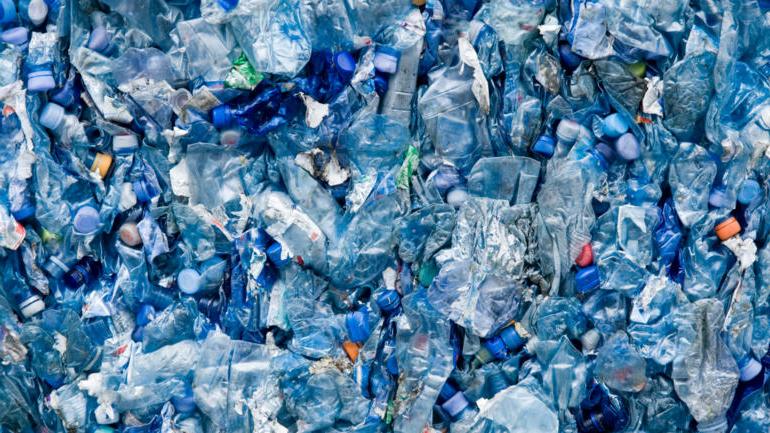The world’s current economic system is reliant on access to low-cost and readily available resources. The wastes building up in our coastal and marine environments are a notable symptom of this take-make-and-dispose model, 也被称为线性经济. 近年来, 2015年,一次性塑料包装废弃物已成为一个主要问题, this accounted for approximately 47% of the plastic waste generated globally.
The qualities that make this type of material effective in preserving goods and being produced in high volumes are the same ones that make it problematic -- single-use plastic packaging is often light, 便宜的, 灵活的, 并持续数千年. 然而, 它的低价值使其难以回收和转售, 这使得它更容易受到管理不善和处置不当的影响.
Asia lies at the center of the global plastic pollution crisis resulting from this linear economy. In 2015, the Ocean Conservancy estimated that up to 60% of marine plastic pollution comes from five countries in Asia: the Philippines, 印尼, 泰国, 越南, 和中华人民共和国(PRC). One approach to reducing single-use plastic packaging waste is transitioning to a circular economy. A circular economy redefines current production and consumption patterns in a way where business and growth support positive economic, Society, 以及整个供应链的环境效益, 商业模式, 生命周期, 从原材料的选择, 产品/服务的设计, 到回收和报废. 就像线性经济, a circular economy still aims to meet basic human needs and generates economic benefits but leaves minimal environmental impact. Effective resource management in a circular economy could create nine to 25 million jobs. 私人投资者可以 最多可节省2美元.9 trillion a year by 2030 as a result of the lowered costs of raw materials and the promotion of employment and innovation.
The coronavirus disease (COVID-19) pandemic has not only hit the pause button on global economies and daily life, 但也 打破废物价值链 医疗和塑料垃圾也显著增加. 这为使用更可持续的模式进行重建提供了机会, 创造绿色和有弹性的生计, 推动技术创新. 技术创新可以帮助企业, 政府, and communities transition to an inclusive circular economy faster and more efficiently.
有五种方法可以推动这种转变:
1. Increase investments in effective integrated solid waste management systems and infrastructure.
解决方案之一是将废物价值链中的流程数字化. 在最近结束的 亚行通过处理实现废物收集数字化的数字挑战, 跟踪, 及循环再造至弃置,获胜组 RECITY, 演示了他们的移动应用程序如何集成高级GIS数据, 社区参与, 透明度, 以及女性赋权, leading to higher revenues for the most vulnerable persons in the supply chain.
2. Strengthen governmental policies, regulations, and commitments for a circular plastics economy.
We need the right enabling environment to transform the way that plastic packaging and products are designed, 使用, 并通过回收来提振市场,创造新的塑料经济. The government of 印尼 set an ambitious target to reduce marine plastic waste by 70% by 2025. Redesign of plastic products and packaging for reuse or high-value recycling is one of the five strategies under its Plan of Action on Marine Debris. This includes developing a world-leading packaging design program or institute in 印尼, 哪一个能把政府联合起来, companies and academia to ensure that design is tailored to the particular needs of emerging-market waste collection and recycling systems.
3. Boost stakeholder engagement and value chain commitments to combat plastic pollution and introduce circular economy practices.
若干涉及民间Society组织的联盟和联盟, 公司, 垃圾收集器, 回收商, 政府也在全国范围内成立, 区域, 在全球层面实现减少废物和回收利用的目标, 比如 全球塑料行动伙伴关系国家塑料行动伙伴关系; 终结塑料垃圾联盟, 摆脱塑料美国和泰国 塑料和废物管理公私伙伴关系.
4. Rethink current delivery models and invest in innovation, pilots, and demonstration projects.
In many countries in Asia, many personal care and home care products come in single-use sachets. 据估计, 菲律宾每天处理1.63亿个一次性小袋. 2018年, 海洋废物教育根除塑料(SWEEP) project launched a pilot of micro-refilling systems in eight small convenience stores in the Philippines. 快速移动的家居用品,如织物调理剂, 食用油, 醋, and soy sauce were dispensed into reusable or repurposed containers in incremental volumes and price points similar to products in single-use sachets. 在短短七个月里, 示范项目成功防止了45枚核弹的使用和处置,000片塑料.
5. 向他人学习.
The circular economy is unknown territory for many 政府 and organizations, but there are successful case studies and working models to draw inspiration from. 中华人民共和国 取得了重大进展. 自2016年以来, 扩展生产者责任计划 has been engaging the electronics, automobiles, lead-acid batteries, and packaging industries. The law requires producers to establish a system for recycling 使用 or end-of-life products by themselves or third parties. The amount of materials recovered and recycled must match the producers’ sales volume.
Recognizing the valuable role that technology innovation plays in the transition to a circular economy, 亚行已推出 科技创新挑战(TIC),防止塑胶废物. The TIC seeks digital or mechanical plastic waste preventive technologies that could support (i) the transformation of current delivery systems of fast-moving consumer goods, 比如食物, 饮料, 和个人或家庭护理产品重复使用和补充模型, 及/或(ii)逆向物流服务, which are designed to return 使用 goods and packaging back to the business or retailers and onwards to a destination that captures value or responsibly disposes of the products and materials. The deadline for submitting Expressions of Interest is on November 27, 2020.
一次性塑料垃圾是一个大问题,需要大的解决方案. 技术创新是向包容性转型的关键推动因素, 只是, 以科学为基础的循环经济.
本文最初发表于 亚洲开发银行








